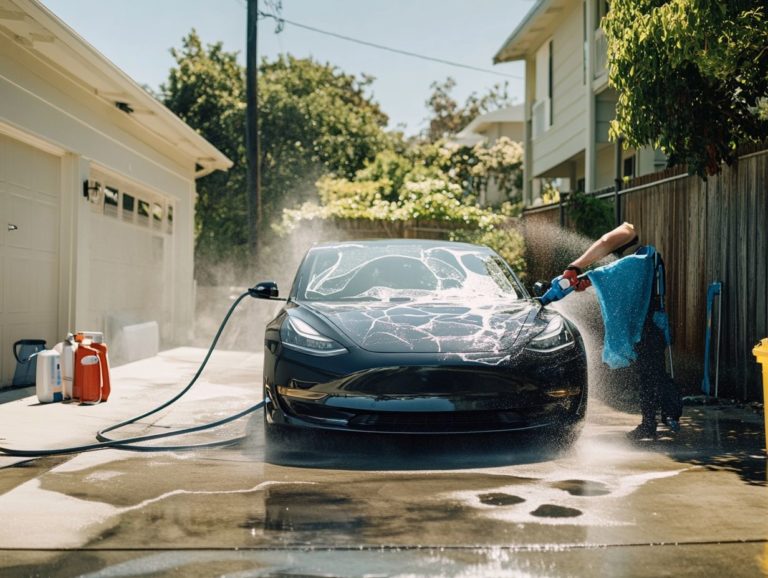understanding the electric vehicle cooling system
Electric vehicles (EVs) are revolutionizing your perspective on transportation! But have you ever paused to reflect on the crucial role of cooling systems in enhancing their performance and longevity?
This article delves into the complexities of EV cooling systems. It examines essential components such as battery, motor, and cabin cooling mechanisms, along with a comparison of air and liquid cooling methods.
You ll uncover how these systems operate, gain valuable maintenance tips, and identify common issues that may arise. Explore why effective cooling is paramount for a seamless and efficient driving experience!
Contents
- Key Takeaways:
- Components of an Electric Vehicle Cooling System
- Types of Cooling Systems
- How the Electric Vehicle Cooling System Works
- Keep Your EV Cool: Maintenance Tips
- Frequently Asked Questions
- What is an electric vehicle cooling system?
- How does an electric vehicle cooling system work?
- What are the main components of an electric vehicle cooling system?
- Why is an electric vehicle cooling system important?
- Do All Electric Vehicles Have the Same Cooling System?
- What Are Common Issues with Electric Vehicle Cooling Systems?
Key Takeaways:
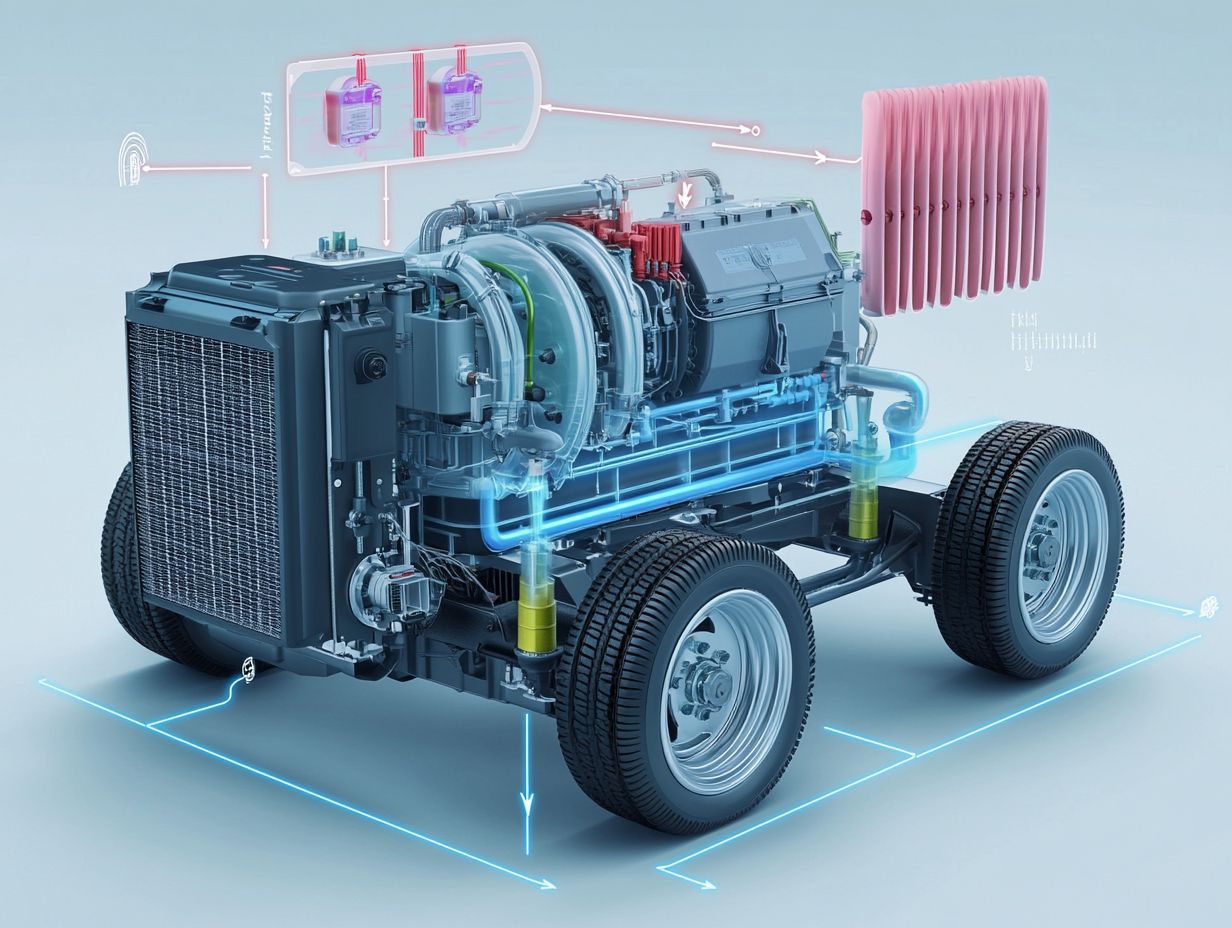
- Cooling is crucial for EV performance and longevity.
- The cooling system includes battery, motor, and cabin cooling.
- Two main types of cooling systems are air and liquid cooling, each with unique benefits.
Why is Cooling Important for Electric Vehicles?
Cooling is a crucial element in the realm of electric vehicles (EVs). It directly impacts the performance and safety of EV batteries. Keeping temperatures optimal boosts performance. It also helps extend the battery’s lifespan.
Effective temperature management can significantly reduce the risks of overheating how amazing is that? This helps prevent catastrophic failures within battery systems, boosting the overall reliability and efficiency of electric vehicles.
With increasing concerns about battery degradation and environmental implications, advanced cooling techniques have become essential for achieving sustainable mobility and energy efficiency in the EV market.
Implementing robust thermal management systems is vital for protecting the longevity and functionality of your battery packs. Liquid cooling and air cooling are two widely used methods, each catering to different operational needs.
-
Liquid cooling, often hailed as the more efficient option, circulates coolant through channels in the battery pack. This maintains a steady temperature, lowers temperatures during high-demand situations, and ensures a more uniform heat distribution across the cells.
-
On the other hand, air cooling relies on airflow. While it is simpler and lighter, it may not meet the demands of high-performance applications.
Both methods aim to mitigate risks such as battery swelling or reduced capacity. This highlights the intricate connection between effective cooling and overall vehicle safety.
Components of an Electric Vehicle Cooling System
The cooling system of your electric vehicle consists of several essential components. Each is carefully designed to manage the heat produced by the battery packs, electric motor, and cabin environment.
The Heating, Ventilation, and Air Conditioning (HVAC) system is pivotal in maintaining not just passenger comfort, but also ideal temperatures for effective battery thermal management.
This interplay of systems ensures that everything operates efficiently, ultimately enhancing the performance and longevity of your electric vehicle.
Battery Cooling System
The battery cooling system plays a vital role in the longevity and performance of EV batteries. It employs various strategies to manage heat dissipation and maintain optimal operating temperatures.
By utilizing advanced battery thermal management systems, you can ensure efficient coolant circulation. This prevents overheating and extends the lifespan of your battery packs.
In this realm, two primary techniques stand out: liquid cooling and air cooling.
- Liquid cooling systems circulate a coolant through channels within the battery pack. This facilitates heat transfer far more effectively than air, thus maintaining a consistent temperature.
- Conversely, air cooling relies on ambient air to dissipate heat. It may be less effective in extreme conditions but boasts a simpler design and implementation.
Both methods significantly enhance battery efficiency by reducing thermal gradients. This not only preserves battery capacity but also boosts charging speed. Understanding these systems is essential for developing next-generation electric vehicles that demand exceptional reliability and performance.
Ready to dive deeper into EV technology? Explore our additional resources!
Motor Cooling System
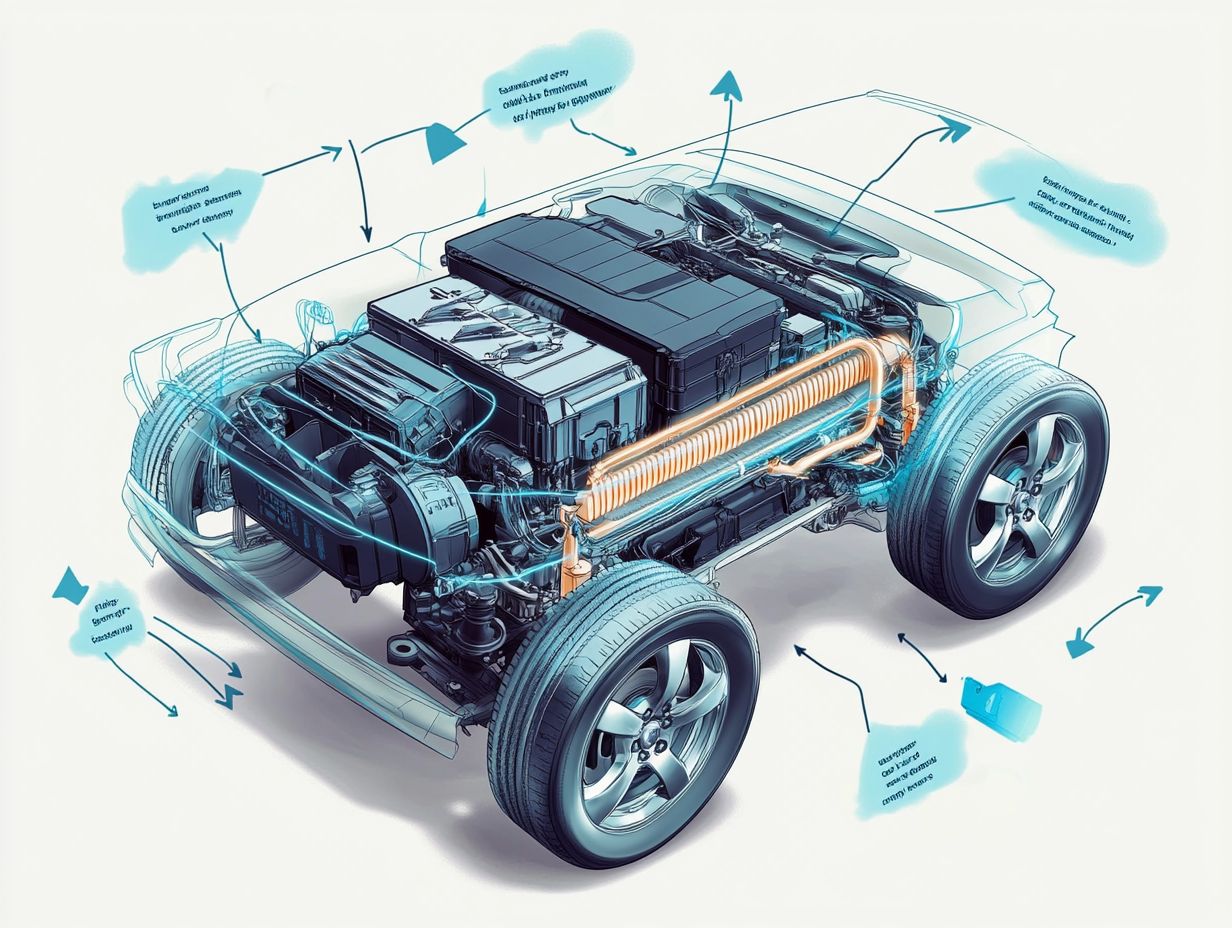
The motor cooling system in electric vehicles regulates the temperature of the electric motor. This ensures stable performance and prevents overheating during operation.
Efficient temperature control maintains optimal efficiency and prolongs the electric motor’s life. This directly impacts your vehicle’s overall performance.
Technologies used include air cooling and liquid cooling methods.
- Air cooling uses fans or natural airflow to dissipate heat. It s a simpler and cost-effective solution but may struggle in high-performance situations.
- Liquid cooling circulates coolant through specialized channels. This method allows for superior heat transfer, essential during high-demand scenarios.
Effective motor cooling is essential for maximizing your battery’s performance! Elevated temperatures can adversely affect battery lifespan and performance. Therefore, integrating advanced cooling technologies is crucial for enhancing vehicle efficiency and ensuring reliable operation across various driving conditions.
Cabin Cooling System
The cabin cooling system in electric vehicles is often seamlessly integrated with the HVAC system. It plays a vital role in ensuring your comfort while also influencing battery performance.
By effectively managing cabin temperature, the vehicle operates within its optimal thermal ranges, significantly enhancing both efficiency and safety.
This balance between your comfort and battery longevity is essential. Excessive heat can wear down battery life and reduce the vehicle’s range. Effective thermal control not only regulates cabin temperatures but also keeps the battery pack within its ideal operating range.
By utilizing advanced cooling technologies, electric vehicle manufacturers boost energy efficiency, maximizing your driving range and performance. A well-optimized cabin cooling system can facilitate rapid recovery during quick charging, ensuring your vehicle returns to its optimal operational state promptly.
Types of Cooling Systems
Electric vehicles employ a range of cooling methods, primarily divided into air cooling and liquid cooling systems. Each type presents unique advantages in managing battery temperature and enhancing overall vehicle performance.
Understanding these cooling systems is crucial for maximizing battery lifespan and ensuring optimal thermal performance across varied operating conditions.
Air Cooling vs. Liquid Cooling
Air cooling and liquid cooling are the two primary methods of thermal management in electric vehicles. Each is designed to meet specific coolant requirements based on the vehicle’s design and performance goals.
While air cooling systems are simpler and lighter, liquid cooling systems excel in heat dissipation and are generally more efficient for high-performance electric vehicle applications.
In the rapidly evolving world of electric vehicles, understanding these cooling methods is essential for optimizing battery longevity and performance. Tesla, for instance, utilizes liquid cooling in their vehicles for effective thermal management during high-demand situations like rapid acceleration or long-distance travel.
Conversely, vehicles such as the Nissan Leaf rely on air cooling. While cost-effective and straightforward, it may struggle to maintain optimal temperatures under extreme conditions. The Chevy Volt takes a hybrid approach, effectively balancing both systems to cater to various use cases.
By evaluating these methods, you gain valuable insight into how battery thermal management enhances vehicular efficiency and the overall driving experience.
How the Electric Vehicle Cooling System Works
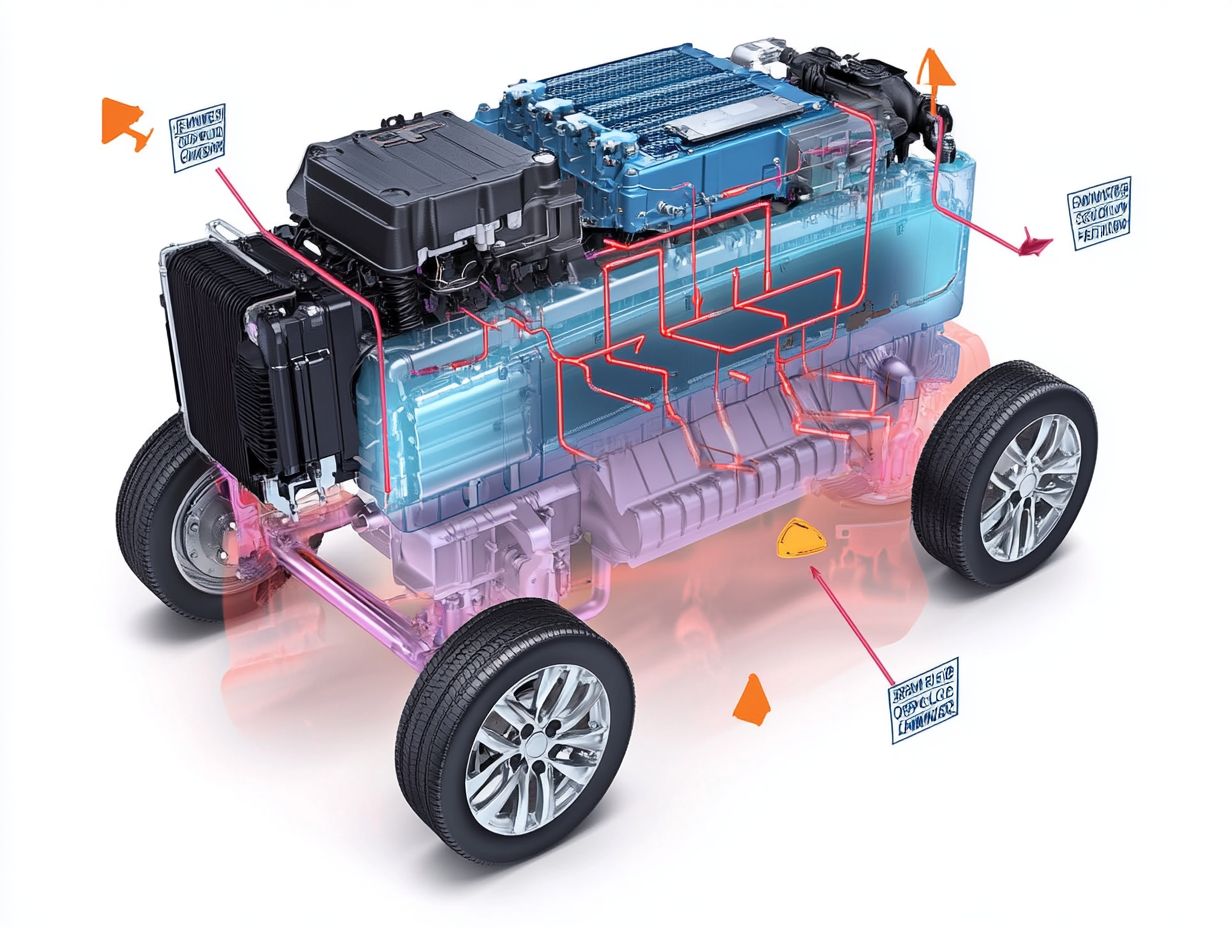
The operation of an electric vehicle cooling system hinges on coolant flow and heat transfer, both essential for preserving battery efficiency and performance.
By leveraging advanced battery thermal management systems, electric vehicles adeptly navigate temperature fluctuations during diverse conditions, such as high charge cycles and extended driving periods.
Coolant Flow and Heat Transfer
Coolant flow and heat transfer are vital for the smooth operation of electric vehicle cooling systems. They ensure that your batteries and motors stay within safe thermal limits while you drive.
The choice of coolant fluids and the design of the cooling circuit greatly impact how well the coolant circulates and the system’s overall thermal performance.
In your electric vehicle, maintaining optimal coolant flow is essential for preventing overheating. Overheating can reduce battery life and efficiency, which is something you want to avoid.
The typical design features a network of channels and pumps that facilitate this flow, directing coolant through critical components like the battery pack and electric motor.
Using coolants that don’t transfer heat well can enhance heat management by lowering heat transfer rates in specific areas, effectively preventing troublesome hotspots.
Integrating new ways to keep the car cool will further optimize the performance of these coolants, ensuring efficient heat dissipation and promoting the longevity of your vehicle’s essential components.
Keep Your EV Cool: Maintenance Tips
Proper maintenance and troubleshooting of electric vehicle cooling systems are essential for maximizing the longevity and performance of battery thermal management systems.
By learning about common issues in both battery cooling and motor cooling systems, you can take proactive measures to prevent overheating and system failures.
Your diligence in this area will enhance your vehicle’s efficiency and safeguard your investment for the long run.
Common Cooling Problems and How to Fix Them
Common issues in electric vehicle cooling systems can range from coolant leaks to inefficient heat transfer. These problems can significantly impact battery thermal management and overall vehicle performance. Addressing these issues promptly is crucial for maintaining optimal battery performance and avoiding costly repairs.
As a driver, paying close attention to your vehicle s cooling system is essential. Neglecting maintenance could lead to overheating, reduced efficiency, and ultimately jeopardize the longevity of your battery pack.
Regularly checking coolant levels, ensuring there are no obstructions in the cooling ducts, and monitoring the temperature gauge can help you identify issues early.
Using high-quality coolant and inspecting hoses for wear can prevent leaks and ensure effective heat transfer. By taking a proactive approach to troubleshooting, you minimize the risk of serious damage and enhance your vehicle’s overall reliability, significantly extending the battery’s lifespan. This results in better performance on the road.
Watch this video to learn more about electric vehicle cooling systems!
Frequently Asked Questions
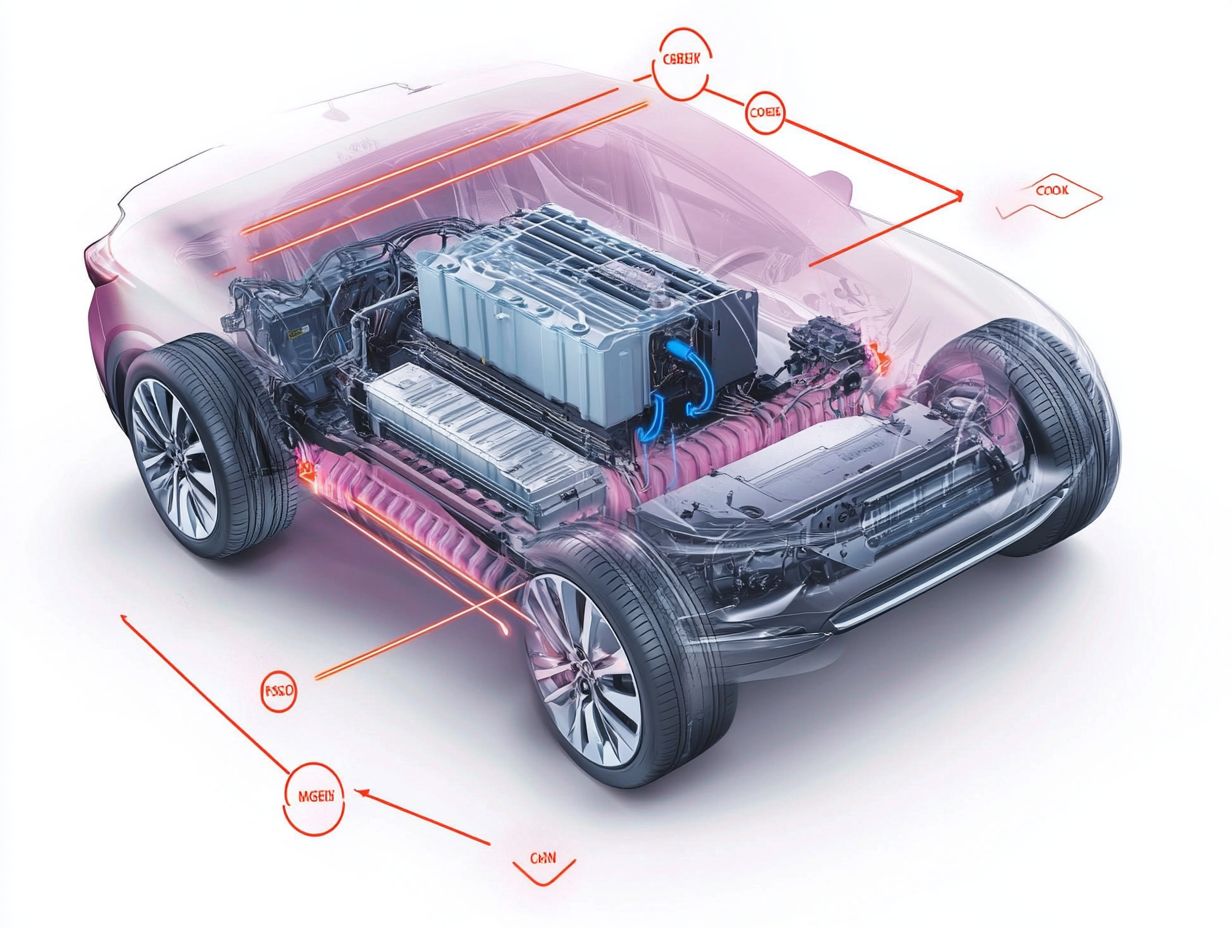
What is an electric vehicle cooling system?
An electric vehicle cooling system is a crucial component that maintains the proper operating temperature of an electric car’s powertrain, battery, and other important systems. It dissipates excess heat generated during the vehicle’s operation and prevents overheating.
How does an electric vehicle cooling system work?
The cooling system uses a combination of liquid cooling and air cooling to regulate the temperature of the electric vehicle’s components. The liquid, typically a water and coolant mixture, is pumped through channels in the powertrain and battery. Meanwhile, the air cooling system uses fans to draw cool air over the components and dissipate heat.
What are the main components of an electric vehicle cooling system?
The main components include the radiator, water pump, thermostat, hoses, fans, and coolant reservoir. The radiator cools the liquid coolant, while the water pump circulates it through the system. The thermostat controls the flow of coolant, and the fans help dissipate heat. Hoses and the coolant reservoir connect and store the liquid coolant.
Why is an electric vehicle cooling system important?
An electric vehicle cooling system is vital because it maintains the proper functioning and longevity of the vehicle’s components. Overheating can lead to damage and reduced efficiency, ultimately affecting the performance and lifespan of the electric car.
If you have any further questions, feel free to reach out or check your vehicle’s cooling system regularly!
Do All Electric Vehicles Have the Same Cooling System?
No, electric vehicles differ in their cooling systems. The design and components depend on the vehicle’s make, model, and the system that powers it.
Some electric cars use only liquid cooling, while others combine liquid and air cooling methods.
What Are Common Issues with Electric Vehicle Cooling Systems?
Common problems include leaks, clogs, and fan issues. Leaks can happen in hoses or the radiator, leading to coolant loss.
Clogs can interrupt coolant flow and cause the vehicle to overheat. Fan issues can also result in overheating if heat isn’t dissipated effectively.




